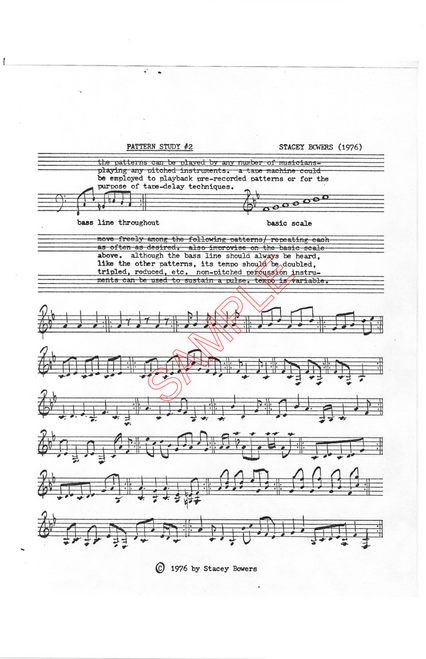Includes score.
In the composer's words, "These short pieces were written in 1977 and 1978 during a time when I was often performing some of the Sonatas and Interludes for prepared piano by John Cage. After preparing and unpreparing many pianos I thought it would be interesting to prepare a marimba, my primary instrument. Objects are attached to the rosewood bars, rubber mutes placed between bars, resonators are covered, etc. I premiered both pieces in 1978 at the ARC Gallery in Chicago. This was at a concert by La Boue, a group I worked with during that era. The scores were lost until recently, when they surfaced in the La Boue archive."
Print size: 11 x 13.5"
Review from Percussive Arts Society:
Study #3 and Study #5
Stacey Bowers
Throughout music history, a number of contemporary composers found that altering the colors of sounds on traditional instruments would make their works unique. Some of them also built their own instruments or altered existing ones. Lou Harrison, John Cage, and Harry Partch are three that are common. This publication expands the colors on a 4-octave marimba. On the opening page there is a detailed drawing of the keyboard, with various types of devices to prepare the instrument. These include straw, wax paper, cork, and metal. Some are wedged on or between the bars, and some are placed over the resonators.
The first work, “Study #3,” is just one page in length but has three sections. The first features two arpeggios that set up the rhythmic ostinato in the left hand, which stays steady for this section, while the right hand performs a pattern of dotted-eighth notes with occasional sixteenth notes over the bass pattern. This movement slows to legato, non-metered, single-note patterns.
The second work, “Study #5,” is a collection of phrases that are grouped as slow, faster, fast, and slower. The concept has several short rhythmic patterns that vary with quintuplets, triplets, and binary patterns. The dynamics vary in extremes, as does the tempo. —George Frock, 2020
Demo:







